#Sangorski & Sutcliffe
Text
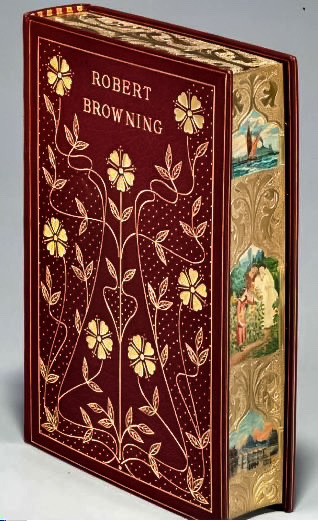
THE POETICAL WORKS OF ROBERT BROWNING (London: Ballantyne, Hanson & Co., 1899)
Red morocco art binding by Sangorski and Sutcliffe. Gilt and gauffered edges, and fore-edge paintings by Fazakerley.
source
#beautiful books#book blog#books books books#book cover#books#vintage books#book design#book binding#art binding#robert browning#poetry#gauffered#fore edge painting#fazakerley#sangorski and sutcliffe
71 notes
·
View notes
Text

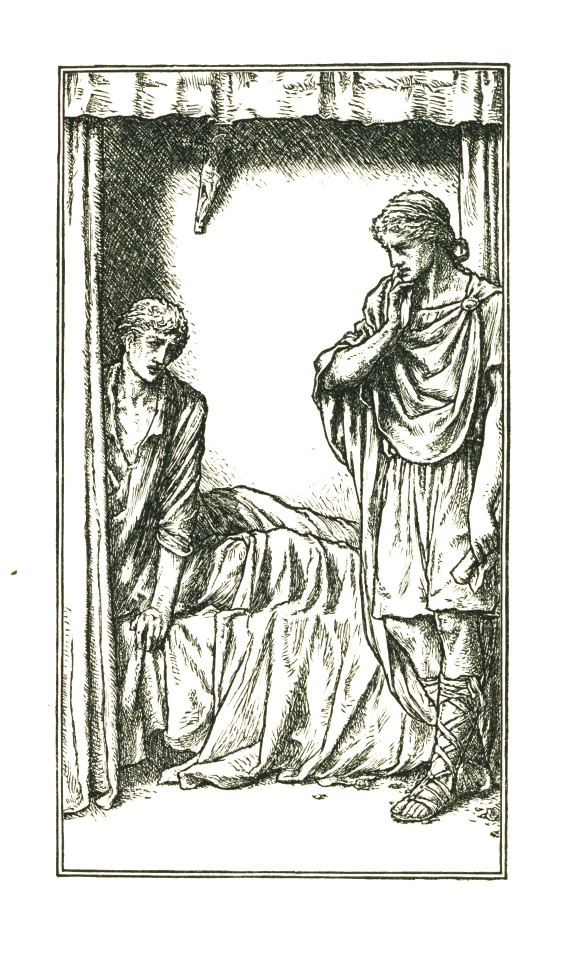
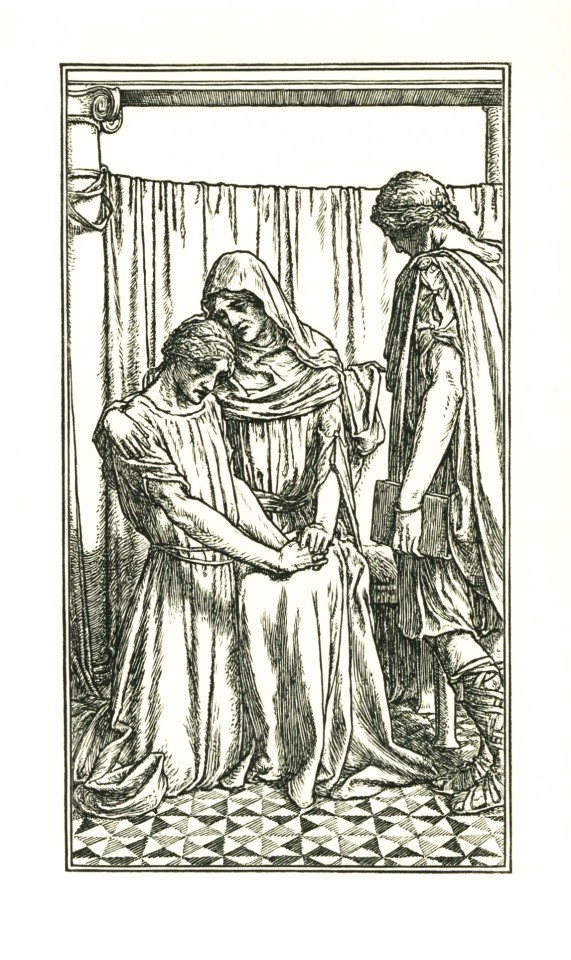

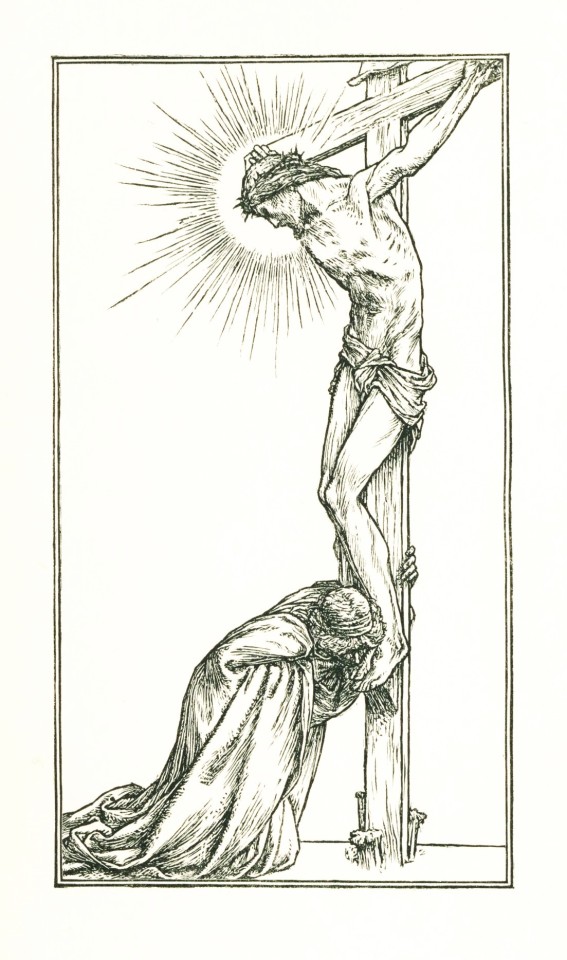
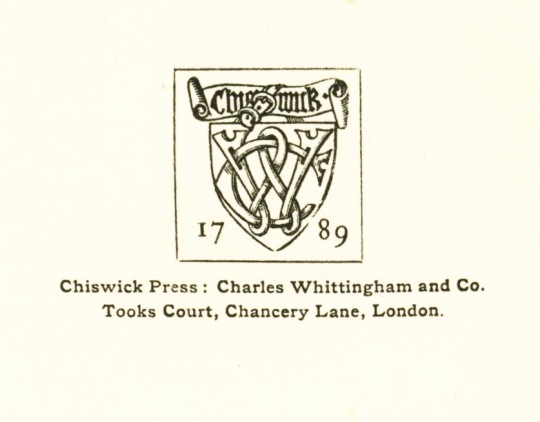
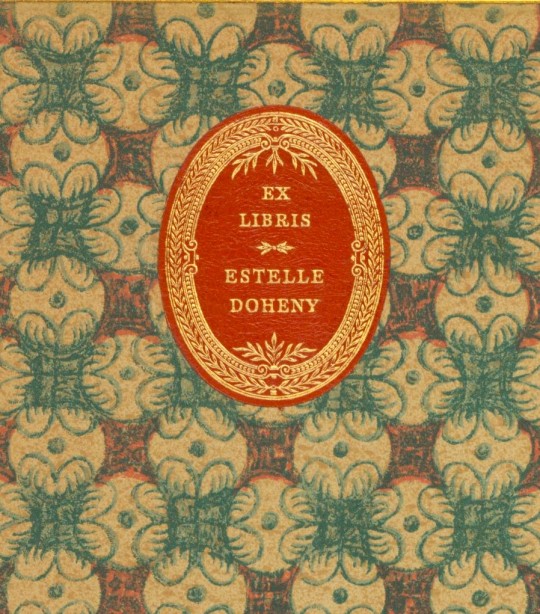

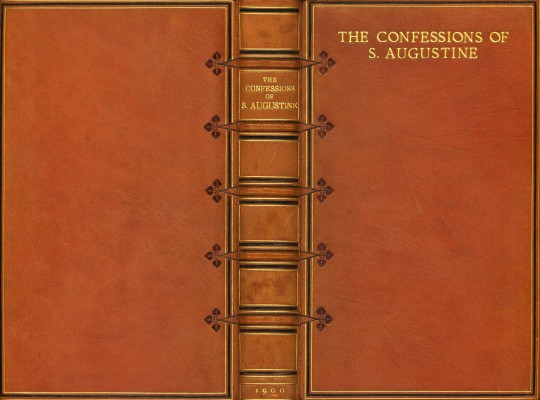

Wood Engraving Wednesday
This week we present a few wood engravings by English artist, writer, and suffrage activist Clemence Houseman (1861-1955) from a 1900 edition of The Confessions of St. Augustine published in London by Kegan Paul, Trench, Trübner & Co. Houseman worked from illustrations designed by British book illustrator Paul Woodroffe (1875-1954) and a title-page border designed by her brother Laurence Housman (1865-1959), with whom she was very close. Her other notable sibling was the classical scholar and poet A. E. Houseman (1859-1936).
The book was printed on Arnold and Foster's unbleached handmade paper and printed by Charles Whittingham and Co. of the Chiswick Press and was formerly owned by renowned book collector and philanthropist Estelle Doheny, and bears her bookplate. The book was full bound in brown, tooled, Morocco goatskin with patterned endsheets by the notable London bookbinders Sangorski & Sutcliffe for the J. W. Robinson Company, a southern California department store company which maintained a book department. Our copy is another donation from the estate of our late friend Dennis Bayuzick.
View more posts with wood engravings by Clemence Houseman.
View more posts with bindings by Sangorski & Sutcliffe.
View other books from the collection of Dennis Bayuzick.
View more posts with wood engravings!
#Wood Engraving Wednesday#wood engravings#wood engravers#women wood engravers#Clemence Houseman#Paul Woodroffe#Laurence Houseman#The Confessions of St. Augustine#Kegan Paul Trench Trübner & Co.#Charles Whittingham and Co.#Estelle Doheny#Sangorski & Sutcliffe#J. W. Robinson Company#Dennis Bayuzick
35 notes
·
View notes
Text

A Dream of Fair Women. Alfred Tennyson. Illuminated and Bound by Sangorski & Sutcliffe, London, 1905-1911
17 notes
·
View notes
Photo










Only black-and-white images exist of the first Great Omar but a digital colourisation was created in 2001
The book that sank on the Titanic and burned in the Blitz
By Tim Stokes BBC News
Published 15 April
One of the most lavishly decorated books the world has seen was despatched from London to New York in April 1912. The jewel-encrusted edition of the Rubáiyát of Omar Khayyám was taken aboard the RMS Titanic and sank to the bottom of the Atlantic Ocean, exactly 110 years ago.
A replacement was finished at great expense by the late 1930s but it was promptly incinerated by German bombers as the British capital was ravaged during the Blitz.
The young man behind this extravagant presentation of the polymath Khayyám's poetry would soon drown in an English seaside resort.
Would anyone dare to commission a third "Great Omar"?
'The greater the price the more I shall be pleased'
In 1911, Francis Sangorski finished work on a binding he had been labouring over at his Holborn workshop for two years.
It was breathtakingly magnificent.
Measuring 16in by 13in (40cm by 35cm), the book was encrusted with 1,050 jewels including specially cut rubies, topazes and emeralds. About 100sq ft (9sq m) of gold leaf and some 5,000 pieces of leather were used in its creation.
Sangorski agonised over every detail, at one point borrowing a human skull so he could accurately depict it in his artistic vision. He even bribed a keeper at London Zoo to feed a live rat to a snake so he could capture the grisly image from first-hand experience.
The Daily Mirror considered the finished work to be "the most remarkable specimen of binding ever produced". Others simply described it as the "Book Wonderful".
It was given an enormous price tag.
Bookbinder Sangorski and his business partner George Sutcliffe were already highly regarded for their elaborate jewelled covers.
"Real jewelled bindings were like Fabergé eggs," explains Rob Shepherd, managing director of Shepherds, Sangorski & Sutcliffe - the 21st Century iteration of the company the two men set up in the Edwardian era.
"They were of a level which would be very hard to replicate today as there's been a loss of skills over the years. The trade in those days was very skilled. They were extraordinarily talented craftsmen."
The pair had met in 1897 at evening classes, where they were taught by the best as apprentices to a line of craftsmen who went back to the Arts and Crafts movement's William Morris and included the eccentric TJ Cobden-Sanderson - a man who ended his career by throwing blocks of his own typeface off Hammersmith Bridge and into the River Thames so that nobody could copy him.
Sangorski and Sutcliffe's work stood out and they won prestigious bookbinding commissions, including for King Edward VII.
In 1907, Sangorski met John Stonehouse, manager of Sotheran's bookshop, which was founded in 1761 and is still in business today. Sangorski told him about his dreams for a book whose origins went back to the 12th Century.
While Sangorski had bound some versions of the renowned Rubáiyát of Omar Khayyám before, the master craftsman said that this time he wanted to create a work featuring three peacocks he would surround with jewelled decoration "such as had never been seen before".
After much persuasion, Stonehouse agreed to commission it. He decided against telling his boss Henry Cecil, fearing Cecil would oppose the project.
Stonehouse stipulated a set of guidelines.
"Do it and do it well; there is no limit. Put what you like into the binding, charge what you like for it - the greater the price the more I shall be pleased - providing only that it is understood that what you do, and what you charge for it will be justified by the result, and the book when finished is to be the greatest modern binding in the world.
"These are the only instructions."
'The most remarkable binding ever designed'
The book consisted of six different panels: the front and back covers, the inside of the two boards - known as doublures - and two end leaves adorned with peacocks, plants, skulls and Persian patterns symbolising life and death.
For both boards, hundreds of pieces of coloured goatskin needed to be prepared and cut, numerous jewels had to be set in place each within their own individual clasp, and weeks were spent applying intricate gold tooling across all the surfaces.
"It was the most extraordinary piece of work," says Mr Shepherd. "It was very much of its time; the exuberance of Edwardian England just before war broke out."
Stonehouse was similarly impressed, describing it as "the finest and most remarkable specimen of binding ever designed, or produced, at any period, or in any country".
The Rubáiyát of Omar Khayyám
The philosopher, mathematician, astronomer and poet lived in what is now Iran, between 1048 and 1131. His achievements included creating the most precise solar calendar of the time but long after his death he would become more famous for his poetry, written in four-line verses known as quatrains
"These quatrains reflect the sceptic side of Iranian identity, which unbeknownst to many has been as active and profound as the spiritual one," explains Saeed Talajooy, an expert in Persian literature at the University of St Andrews
The poetry covered themes like nihilism, the brevity and the randomness of existence, as well as "the bitter understanding of having no control" and "drinking and forgetting the whole crazy business of life", Dr Talajooy says
A text attributed to Omar Khayyám was translated into English in the mid-19th Century by man of letters Edward FitzGerald. The Rubáiyát flopped at first but was happened upon by two Irish scholars, who helped to win the work widespread acclaim
Experts on the translated version, Sandra Mason and Bill Martin, consider it to be "one of the best-known individual poems on a worldwide basis"
'A fatality seemed to follow it'
With Henry Cecil by now aware of this incredible creation, and the extraordinary effort behind it, Sotheran's put the book on sale for £1,000 - the equivalent of £120,000 today.
"It was three times more expensive than anything else in Sotheran's stock. I think it was just too expensive for the UK market," says the bookshop's managing director, Chris Saunders.
And it wasn't only the price that was an issue. Some were far from dazzled by the Edwardian bling.
"I think that the Omar was probably seen, I mean undoubtedly by some people, as tacky. It was very nouveau riche and the old-fashioned aristocracy were probably quite embarrassed about it," says Benjamin Maggs, a bookseller from the historic London bookshop Maggs Bros Ltd.
A contemporary of that opinion was King Edward VII's librarian at Windsor Castle, Sir John Fortescue. He was among the first to be offered the chance to buy the Omar but declined, later describing it as "the most eminent failure, perhaps, that I ever saw", a work he found "absolutely inappropriate, ineffective and insignificant, and to me personally a positive distress".
Is this the last chance to see the Titanic?
A New York dealer called Gabriel Wells - formerly Weis - happened to be in London in the summer of 1911 and was more impressed. He offered £800 for the book.
This was declined by Sotheran's, which told him he could have it for £900. Wells refused and soon returned to the US.
With a lack of interest in Britain, it was decided the Omar should follow him to America, which had a more lucrative book market.
But when it arrived, there was a row about duty with US customs officials and Sotheran's refused to pay up, instead ordering the Great Omar back to London. As the months passed, a buyer still could not be found.
"A fatality seemed to follow the book," Stonehouse later wrote.
"Stonehouse simply had to sell the Great Omar to appease the owner, Cecil, whom he hadn't consulted about commissioning the book, and so in desperation offered it to Gabriel Wells for £900 and then £650," says Mr Saunders.
Wells wouldn't buy it.
"Cecil, in a fit of pique, demanded that it be sold as quickly as possible through auction."
And so on 29 March 1912, the book went under the hammer without a reserve price at the auction house Sotheby's. The London agent of Gabriel Wells paid £405 for it.
'The best place for it was under the ocean'
The Omar was readied for its to return to America. The book narrowly missed a crossing on 6 April and was instead taken aboard the next ship - RMS Titanic.
"The Sotheran's thing is so fascinating," Mr Maggs says. "The instructions that the guy who commissioned it gave: 'There is no limit' - just like for the Titanic itself there was no limit.
"'Make it as big as you possibly can', regardless of whether it's practical or sensible to do that."
The Titanic disaster, in which more than 1,500 people died, is of course one of the most famous events of the 20th Century, yet little is known about what happened to the Omar in its days aboard the ship.
Mr Shepherd considers it likely the book was in the safekeeping of bibliophile Harry Elkins Widener. The 27-year-old and his parents, who came from the two wealthiest families in Pennsylvania, were among the most prominent passengers on the Titanic.
"The duty on the book would have been enormous, so he could have been asked to carry it on under his arm," according to Mr Maggs, who said Widener knew Wells. The shrewd book dealer had already spoken in the press about his disgust that he might have to pay tax on the import.
https://www.bbc.com/news/uk-england-london-57683638?utm_source=pocket-newtab
More on this story
The 'missing' Chinese survivors of the Titanic
Titanic-linked train carriages discovered in yard
Titanic wreck protected under UK and US agreement
How MPs survived the bombs and kept working
What links the Titanic and oatcakes?
BBC's secret World War Two activities revealed
Map reveals UK World War Two bombing sites
Five Titanic myths spread by films
14 notes
·
View notes
Photo

Luxurious binding of The Rubaiyat of Omar Khayam by the bookbinders Sangorski & Sutcliffe (1911). Bedecked with over a thousand precious and semiprecious jewels, it was affectionately dubbed “The Great Omar” and is considered to be one of the most opulent books ever created. The image above is a reproduction. The original was shipped to America for sale in 1912 on a ship called the Titanic and presumably has rotted into nothing at the bottom of the sea (source).
Look to the blowing Rose about us—"Lo,
Laughing," she says, "into the world I blow,
At once the silken tassel of my Purse
Tear, and its Treasure on the Garden throw."
4 notes
·
View notes
Photo



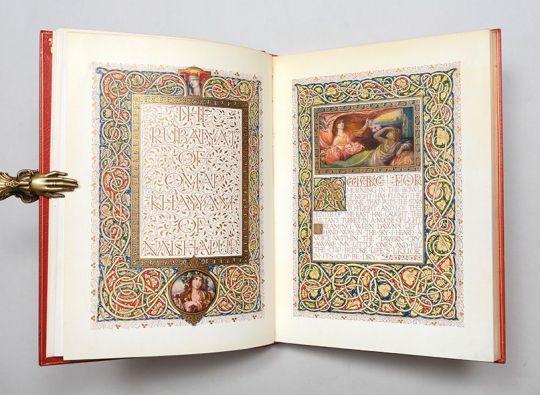

Rubaiyat
Omar Khayyam; Edward Fitzgerald
London: Siegle, Hill & Co., [1911]
First edition thus, number 79 of 550 copies signed by Francis Sangorski and George Sutcliffe and printed on handmade paper (a further 25 were printed on japon), in a striking binding by Bayntun-Riviere, one of the most lavish editions of the Rubáiyát.
47 notes
·
View notes
Photo
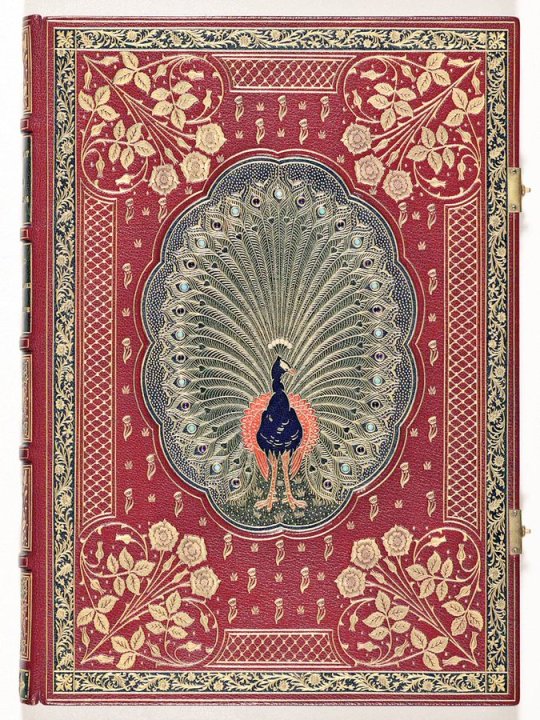
Peacock binding set with 31 jewels of “The Rubáiyát of Omar Khayyám" by F. Sangorski and G. Sutcliffe, London, c. 1910
ArtNouveauDeco@NouveauDeco
49 notes
·
View notes
Text
Ralph Chubb, The Golden City.
Ralph Chubb, The Golden City. (Posthumously published, 1961, in an edition of 18).
Current selling price £3,000+
Ralph Chubb (1892 - 1960) has been called a modern day William Blake, partly because most of his books were exquisitely hand printed in tiny editions, some of which were hand coloured by the artist, and partly because he is seen as an anti-science, visionary Utopian whose principal theme was the redemption of Albion. Unlike Blake, he was a solipsist who placed himself at the centre of a mythology in which golden lads in their teens, cavort through endless sunny afternoons in an earthly paradise of prepubescent innocence. While Chubb’s Uranian verse drew inspiration from people like Walt Whitman, his paintings, many of which are now in public collections, suggest that the painter of naked youth, Henry Scott Tuke, was also an influence.
Chubb is a genuine maverick ---an isolated figure in twentieth century English art, but there is a strong demand for his best work from a devoted, even fanatical, following. An early book, The Sun Spirit, is currently available at $7,500. One avid collector, the Oscar-winning, swinging sixties cinematographer, David Watkin ( The Knack, Help, The Bed Sitting Room ),who died in 2008, owned a number of Chubb titles.
One of the few interesting people to have been born in Harpenden, Chubb moved from the town to nearby St Albans while still a baby and became a pupil (Stephen Hawkin was a later product ), at St Albans School before going up to Selwyn College, Cambridge in 1910. At the outbreak of war he served as an officer with distinction, before being invalided out. In 1919 the army, it would seem, paid for him to attend the Slade School of Art, where he met the print-maker Leon Underwood. His family, who by then were living in Curridge, Berkshire, encouraged him to exhibit his paintings, built a press for him, and a sister helped him get a job as an art teacher in a local school.
Throughout the twenties Chubb produced a string of publications, three of which were commercially printed. One of these, The Book of God’s Madness, explored Manichean ideas reminiscent of Blake. Towards the end of the decade Chubb’s Uranian activities, both in Hampshire and in London, caused a scandal in his village and he was forced to resign from his teaching post. He and his family moved and made their new home at Fair Oak Cottage, among the woods near Ashford Hill, east of Kingsclere. In 1929 Chubb was emboldened to publish his sexual manifesto, An Appendix, using a crude duplicating machine. Soon afterwards he acquired a lithographic press, which he continued using until his death. Like Blake before him, he was now able to integrate drawings and text and publish his controversial work without fear of editorial interference.
Partly because of the Uranian content of these publications, partly because the editions were so miniscule, Chubb has never been regarded as a ‘ fine printer ‘ in the tradition of the Doves Press, Gregynog, and the rest, but was seen more of a visionary and polemicist who happened to work in this exclusive field. His refusal to curb his sexual politics meant that he lived in poverty for most of his working life. His books were hardly money-spinners and his paintings, though praised, lacked the appeal of those by Henry Scott Tuke, and did not sell. Working in his shed studio on the edge of Benskins Wood, haunted by an idyllic childhood and becoming more paranoiac by the year, he ploughed a lonely furrow in the immediate post-war world. During his final years he donated many of his books to the national libraries of the UK.
Chubb may have seen his final project, The Golden City, which contains some of his most engaging poetry, as a possible commercial success, and therefore kept its boy-love content to the minimum. Unfortunately, he did not live to see it finished. At his death in 1960 only the graphic element of the book had been completed, and it was left to his devoted sister Muriel to engage a professional lithographer to complete the printing of the title page, table of contents and colophon. The edition of only 18 copies were then bound by Sangorski and Sutcliffe and dispersed to various interested parties. Today, only five copies are known to exist outside public collections, and these are the uncoloured ones. In fact, The Golden City is so rare that one international dealer in the genre has confessed to never having seen a copy. Other dealers only know it as a legendary ultra-rarity. In the years that followed her brother’s death Muriel also managed to get two other, far less ambitious projects published. The Day of St Alban appeared in 1965 and this was followed by Autumn Leaves (1970). Both are more common, but less sought after than his magnum opus. Perhaps, however, they may be good bets as investments. [R. M. Healey]
Many thanks Robin. Always great to find a Chubb but sadly such finds are infrequent. Last one seen was bound in corduroy, seldom used in binding - there is not even a limited edition of Adrian Bell's 1930 book 'Corduroy' thus bound. The photo of Chubb is enigmatic - does he look bashful or haunted or possibly burning with Pater's 'hard gem-like flame'? There is a definite resemblance to the young Gene Wilder. Are they related?
1 note
·
View note
Text
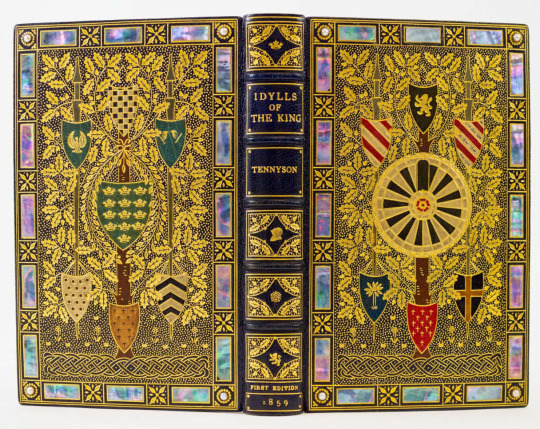
IDYLLS OF THE KING by Alfred Lord Tennyson. (London: Edward Moxon, 1859) Art binding by Sangorski and Sutcliffe.
A magnificent binding in dark blue blue morocco, bejeweled, mother of pearl inlays, all edges gilt, white pigskin end leaves.

source
#beautiful books#book blog#books books books#book cover#books#victorian era#sangorski and sutcliffe#art binding#book design#book binding#idylls of the king#alfred tennyson
77 notes
·
View notes
Photo

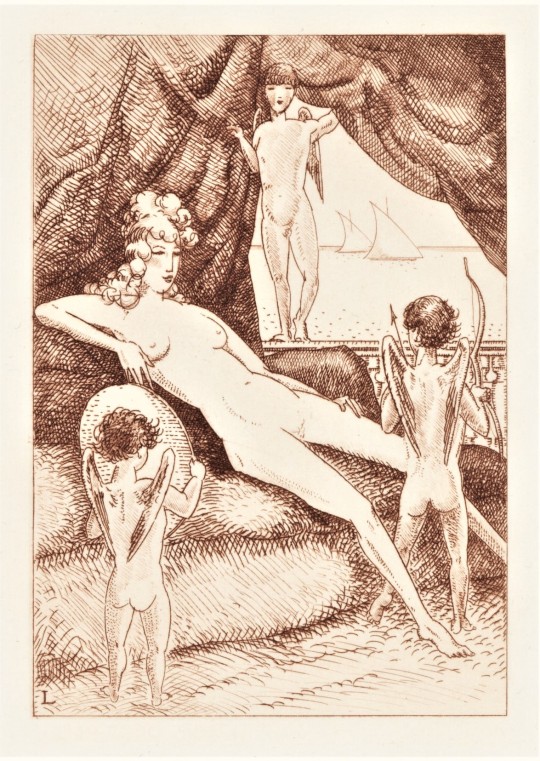








It’s Fine Press Friday!
For this Friday we offer the 1932 Golden Cockerel Press printing of The Amores of P. Ovidius Naso, translated by E. Powys Mathers, with five copperplate engravings by French artist, illustrator, and printmaker Jean Émile Laboureur, and printed in an edition of 350 copies by Robert Gibbings and his wife Moira Pennefather Gibbings.
Robert Gibbings was a prominent wood engraver who owned the Golden Cockerel Press from 1924 to 1933. The press was noted for its distinctive typography and ample use of wood-engraved illustrations. However, although Laboureur had come to Gibbings’s attention because of his wood engravings, Gibbings commissioned Laboureur solely as a copper engraver beginning in 1927. Laboureur would illustrate five titles for Gibbings; The Amores was his final effort for the press. Our copy is quarter-bound in maroon goatskin and green cloth by the notable London book binders Sangorski & Sutcliffe, and is another gift from our friend Jerry Buff.
View other posts with work by the Golden Cockerel Press.
View more Fine Press Friday posts.
#Fine Press Friday#Fine Press Fridays#fine press books#Golden Cockerel Press#Ovid#The Amores#Jean Émile Laboureur#J. E. Laboureur#E. Powys Mathers#Robert Gibbings#Moira Gibbings#Sangorski & Sutcliffe#engravings#copperplate engravings
33 notes
·
View notes
Link
A finely bound example of Burns Works
#old#books#old books#old bookshop#michaelmoonsbookshop#antique bookshop#antique books#vintage#antiquarian bookshop#bibliophile#Robert Burns#Fine Binding#sangorski and sutcliffe#Scottish#Scottish Dialect#Poetry#Edinburgh
10 notes
·
View notes
Photo




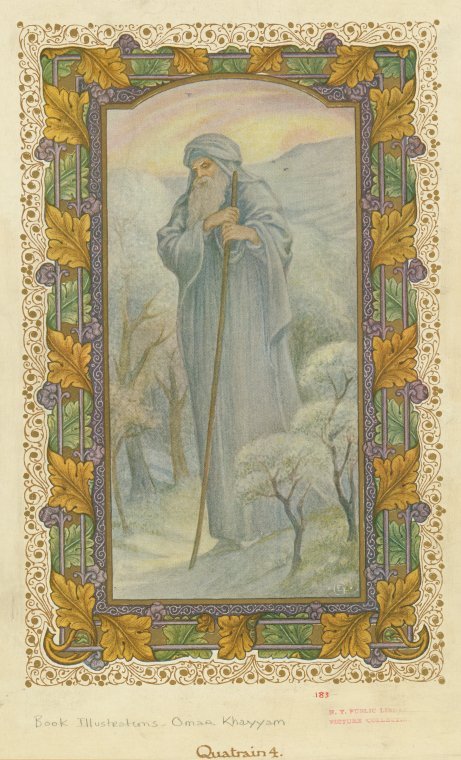
Illustrations from The Rubaiyat of Omar Khayyam of Naishapur by E. Geddes.
Translated by E. Fitzgerald reproduced from a manuscript by Sangorski and Sutcliffe.
Images and text information courtesy NYPL Digital Collection.
66 notes
·
View notes
Photo
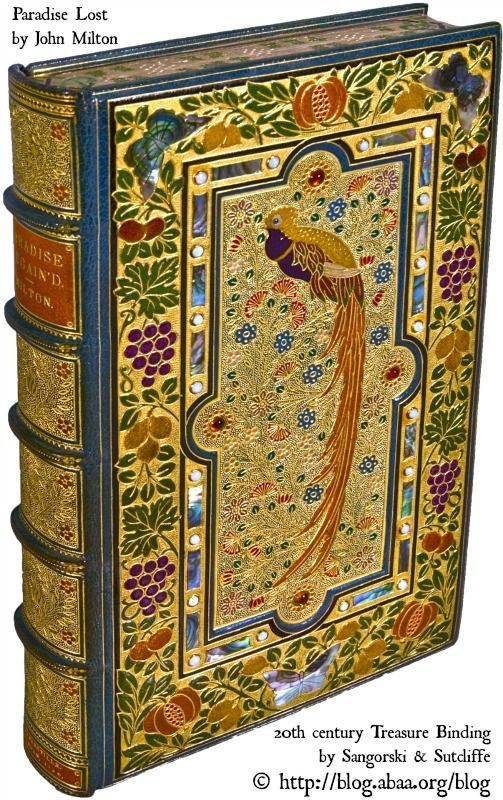
Paradise Lost, 1667, by John Milton (Poet. England, 1608-1674). Epic Poem. 20th century Treasure Binding by SANGORSKI & SUTCLIFFE (Bookbinder
2 notes
·
View notes
Photo
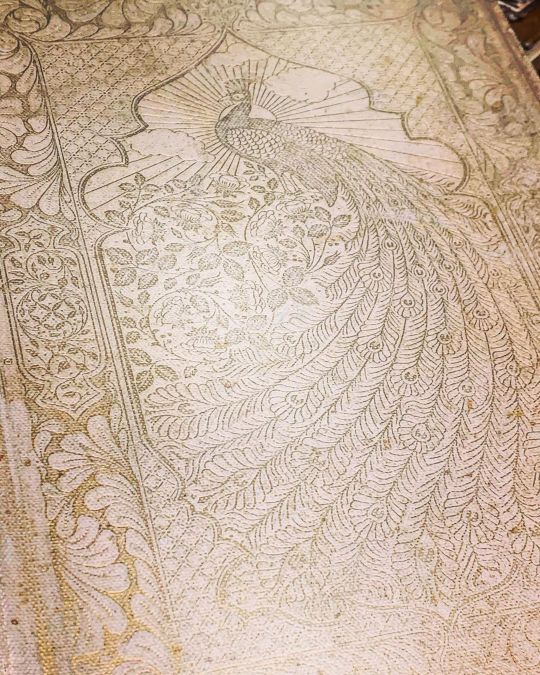
Scroll through a bit of this superb Illustrated Book! 🎉 The Rubaiyat of Omar Khayyam Illustrated and Illuminated by F. Sangorski & G. Sutcliffe! 🙏 This was published out of London by Siegel, Hill & Co. and Engraved and Printed by Andre & Sleigh Ltd. (Note: It has some Foxing and Staining, but nothing to detract from this stunning work!) FOR SALE $325 DM us with interest! (at The Pressroom and Mercantile at The Box SF) https://www.instagram.com/p/CGF1GwWg0m5/?igshid=1iy8twqd5ohr7
0 notes
Photo

We’re in love with this fine binding by Sangorski & Sutcliffe on a copy of Chaucer’s Canterbury Tales. The blind tooling is perfect and those endpapers are to die for! #finebinding #designbinding #bookbinding #bookstagram #specialcollections (at MSU Libraries)
21 notes
·
View notes